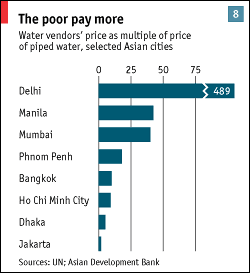|
Periurban Water Supplies
Piped Water for the Poor
|
|
The
poor pay much more (commonly many times more) per cubic meter of water
than the non-poor connected to the urban piped water supply:

|
The Economist, 19 July 2003 |
“Slum-dwellers
in Dar es Salaam pay the equivalent of £4 ($8, €5) for 1,000 litres of water,
bought over time and by the canister. In the same Tanzanian city, wealthier
households connected to the municipal supply receive that amount for just 17p.
In the UK, the same volume of tap water costs 81p and in the US it is as low as
34p” − quote from A costly thirst (Financial
Times, 2008).
So get piped
water to the urban poor!
This is a very effective means of reducing
diarrhoeal disease: see pdf pages 18−20 of:
Water Supply, Sanitation, and Hygiene Promotion (DCPP Working Paper #28, 2004)
See also: Domestic Water Quantity, Service Level and
Health (WHO, 2003)
Purchase of drinking water is associated
with increased child morbidity and mortality among urban slum-dwelling families
in Indonesia (International Journal of Hygiene
and Environmental Health, 2009)
No connection fees! See Water tariffs
See also: New Paradigm for Periurban Water Supplies and Sanitation
Water conservation
Periurbanization − judge the scale of the problem.
Small-scale piped water supplies
Sensitivity of water distribution costs to design and service standards:
a Philippine case study (World Bank, 1986) − Abstract: This report describes a study undertaken in
the Philippines evaluate the impact of changes in design and service standards
on the costs of water supply projects in selected small towns and rural areas. The
studies suggest that in small urban schemes the greatest cost savings could be
achieved by: (a) reducing minimum pipe diameters; (b) limiting per capita use
to 140 liters
per day; (c) providing a mix of home connections and public faucet [i.e., standpipe] service; and
(d) neglecting the fire-demand provisions, which can be done without serious
risk to the community.
Asian Development Bank
In the Pipeline:
Water for the Poor − Investing in Small Piped Water Networks (2008)
Piloting Small Piped
Water Networks (webpage)
Water and
Small Pipes: What a Slum Wants, What a Slum Needs (2007)
Small Piped Water Networks (Water For All #13, undated)
Diagnostic City
Water Assessments: Model Terms of Reference (2006)
Mainstreaming Small
Scale Private Water Piped Network Providers: Model Terms of Reference (2006)
Asian Water Supplies: Reaching the
Urban Poor (2003)
Other
Expanding Piped Water Supply to
Surabaya’s Urban Poor [Indonesia] (World Bank, 2007) − see also here.
Water for the Urban Poor (Tearfund, 2002)
Optimising social
inclusion in urban water supply in Ghana (SWITCH, 2006)
The role of small-scale independent water providers in urban
areas ( Waterlines, 2002)
The urban water
sector: formal versus informal suppliers in India (Urban India, 2003)
Integrated Pro-Poor
Water and Waste Water Management in Small Towns (UN ESCAP webpage)
Hydraulic design
Introduction to Urban Water Distribution (UNESCO-IHE, 2006)
− link to free download.
Also useful:
Safe Piped Water:
Managing Microbial Water Quality in Piped Distribution Systems (WHO, 2004)
Health Aspects of
Plumbing (WHO, 2006)
Urban Water
Security: Managing Risks (UNESCO IHP, 2009) − free download
Is low coverage of
modern infrastructure services in African cities due to lack of demand or lack
of supply? (World Bank, 2009)
Local sources of financing for infrastructure in Africa (World Bank, 2009)
Principles of Town Water
Supply and Sanitation − Part 1: Water Supply (Water Working Note #13, World
Bank, 2007) [Part 2 is Sanitation] − for populations of 2000− 50,000.
Guiding Principles for Successful Reforms of Urban Water Supply and
Sanitation Sectors (Water
Working Note #19, The World Bank, 2009)
Global Experiences on Expanding Services to the Urban Poor
(WSP, 2009)
Improving Water Supply and Sanitation Services for the Urban
Poor in India (WSP, 2009)
|
|
|
|
